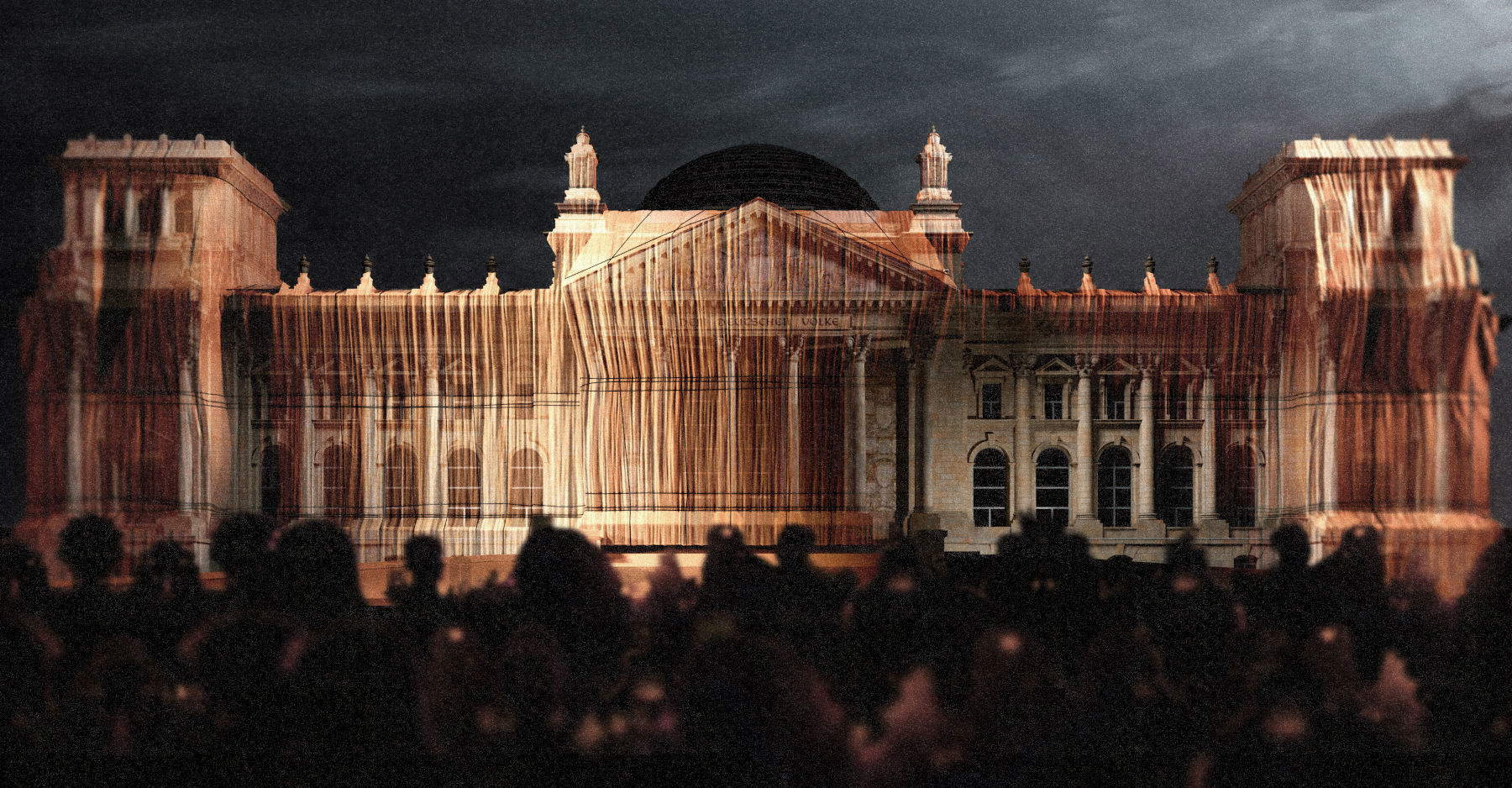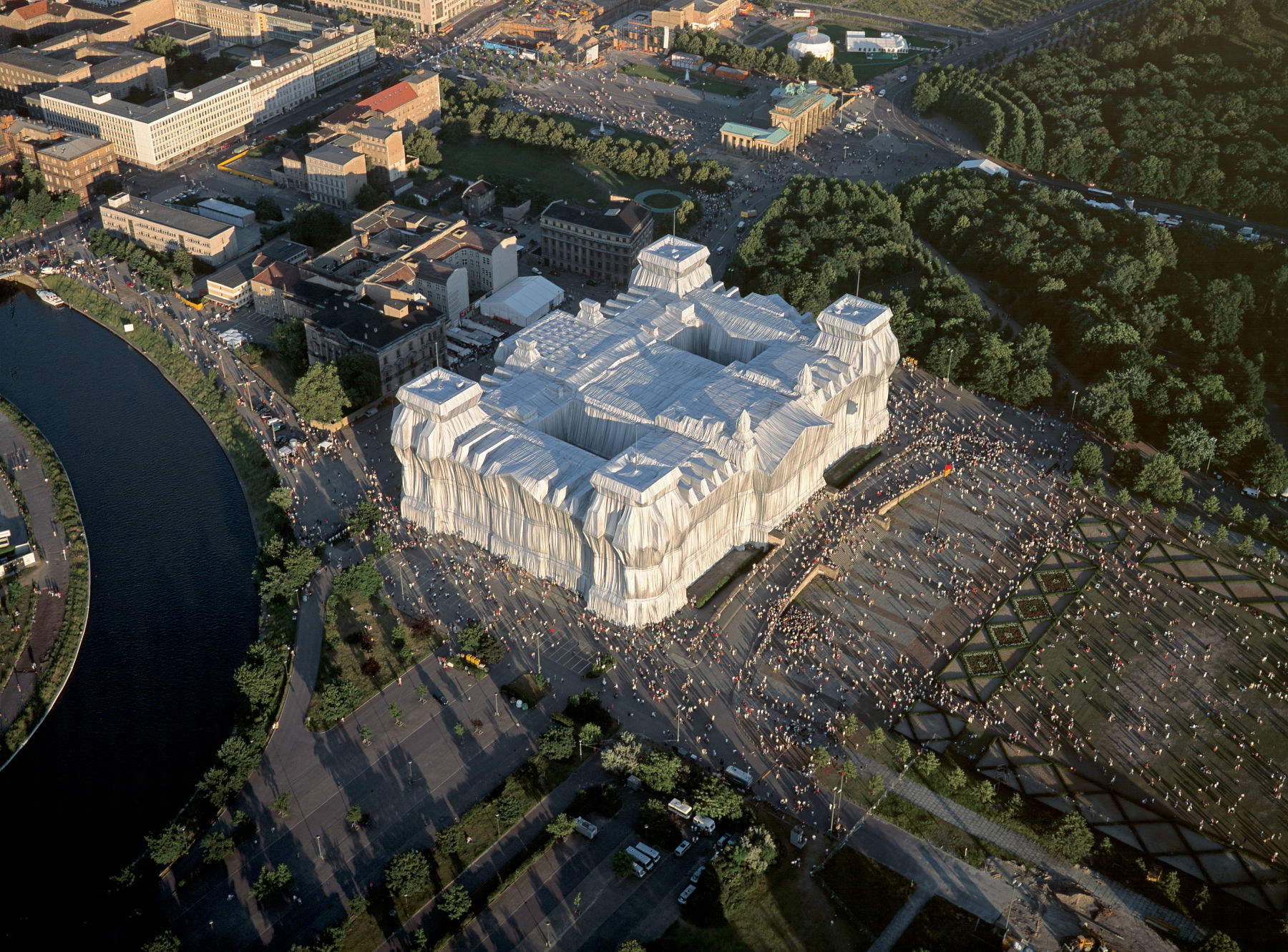In June 2025, Berlin is preparing to commemorate one of the most important events in its recent cultural history: the 30th anniversary of the Wrapped Re ichstag or Wrapped Reichstag, the project created by Christo and Jeanne-Claude that transformed the German parliament building into a temporary sculpture of monumental scale in 1995. To mark the anniversary, a light mapping will be projected on the Reichstag’s west facade each evening from June 9-20, while the Neue Nationalgalerie will host the work Wrapped Volkswagen Beetle Saloon, 1963-2014, a well-known work by the same artist.
The artistic intervention on the Reichstag, completed on June 24, 1995, was the result of a long political and bureaucratic process that spanned more than two decades. Beginning in the 1970s, in fact, the project encountered numerous resistance and institutional obstacles until it was given the green light in the early 1990s. The work was entrusted to a team of 90 professional climbers and 120 skilled laborers, who were tasked with covering the entire building with 100,000 square meters of woven polypropylene fabric with an aluminum reflective surface. The material, silvery and slightly iridescent, was secured with 15.6 kilometers of blue polypropylene ropes.


“In 1971, Christo and Jeanne-Claude conceived the bold idea of wrapping the Reichstag. It took 24 years, including a 70-minute debate in the German parliament, to approve and turn their vision into reality,” recalls Vladimir Yavachev, Christo’s nephew and director of the artist couple’s projects. “In June 1995, just five years after German reunification, Wrapped Reichstag lit up Berlin for 14 unforgettable days, demonstrating the power of imagination and perseverance. Now, 30 years later, temporary projections on this historic building are a powerful reminder of both the history and impact of public art.”
“We invite everyone to this unique event! By setting up the Reichstag as an illuminated shell, we celebrate Berlin, reunification, democracy and art,” say Roland Specker and Peter Schwenkow of the organizing company 30 Jahre Verhüllter Reichstag Schwenkow & Specker GmbH. “It is a tribute to the extraordinary legacy of Christo and Jeanne-Claude and at the same time a gift for Berlin and all the inhabitants of the capital. With this grand light show, we Berliners would like to give thanks for what Berlin was and is: a place of freedom, diversity, joy and a place for people with great visions.”
The planned 30th anniversary tribute will be visible free of charge and will take the form of a nightly light projection, every evening from dusk until 1 a.m., on the building’s west facade. The project was created in collaboration with Roland Specker and Professor Peter Schwenkow, while the visual elements were developed by Paris-based designer Anna Bacheva. Twenty-four synchronized projectors will visually reconstruct the impact of the 1995 work, offering visitors a temporary experience that evokes the original intervention. In parallel, starting June 11, the Neue Nationalgalerie will host one of the artist’s most recognizable three-dimensional works, Wrapped Volkswagen Beetle Saloon, 1963-2014. The work, the result of research begun in the 1960s and completed half a century later, will remain on display for a year in the rooms of the Berlin museum.






“Christo’s work represents an always surprising transformation of everyday life into art. We are very grateful to be able to exhibit an important work by the artist for a longer period,” says Joachim Jäger, deputy director of the Neue Nationalgalerie. "The Wrapped Volkswagen Beetle covered in film is in itself such a German icon that Christo, in a way, has created a new interpretation of Germany."
Although the pair has created numerous large-scale works throughout their careers, the Reichstag intervention is considered one of the most emblematic moments of their work, in terms of technical scope, iconic value and cultural impact. The 2025 projection, while not physically replicating the original work, serves as a visual and historical record of that moment, offering contemporary audiences the chance to reflect on how art has dialogued with structures of power, transforming them for a brief period of time into objects of aesthetic contemplation and collective reflection. The anniversary-related program, which is privately organized and funded, is part of a broader context of commemorative events and cultural initiatives designed to bring attention back to the work of Christo and Jeanne-Claude after the deaths of both. Christo passed away in 2020, Jeanne-Claude in 2009. Both had always reiterated that their projects should be temporary and non-repeatable, but there is nothing to prevent them from being remembered through different means.

Christo and Jeanne-Claude shared the same date of birth: June 13, 1935. Christo was born in Gabrovo, Bulgaria, while Jeanne-Claude came into the world in Casablanca, Morocco. Both lived in New York from 1964, where they died, Jeanne-Claude in 2009 and Christo in 2020. Their careers were marked by monumental works created in all parts of the world: Wrapped Coast, One Million Square Feet, Running Fence, Surrounded Islands, The Pont Neuf Wrapped, The Umbrellas, Wrapped Reichstag, The Gates, The Floating Piers, The London Mastaba and L’Arc de Triomphe, Wrapped. Their first temporary outdoor artwork was in 1961, Stacked Oil Barrels and Dockside Packages. Before moving to the West, Christo studied painting, sculpture, architecture and decorative arts for four years at the National Academy of Art in Sofia. The early creations, Wrapped Cans, Wrapped Oil Barrels, Packages, Wrapped Objects and Store Fronts, along with all preparatory drawings, collages and scale models, can be attributed to Christo. In contrast, the indoor installations and large public projects, whether made or left on paper, are the result of their artistic collaboration.
 |
| Thirty years ago, Christo packed the Reichstag: Berlin pays tribute to the work with an evening screening |
Warning: the translation into English of the original Italian article was created using automatic tools. We undertake to review all articles, but we do not guarantee the total absence of inaccuracies in the translation due to the program. You can find the original by clicking on the ITA button. If you find any mistake,please contact us.